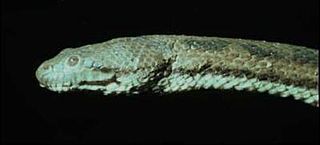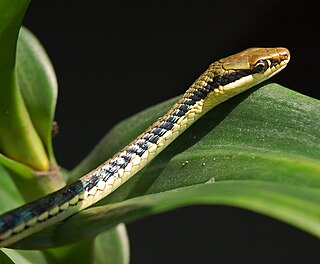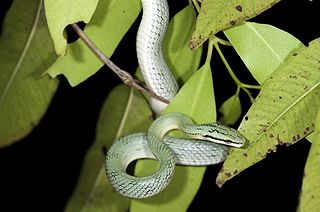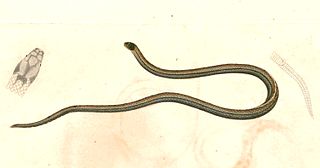
The Homalopsidae are a family of snakes which contains about 28 genera and more than 50 species. They are commonly known as Indo-Australian water snakes, mudsnakes, or bockadams. They are also known as ular air in Indonesian. They are typically stout-bodied water snakes, and all are mildly venomous. Two monotypic genera are notable for their unusual morphology: Erpeton possesses a pair of short, fleshy appendages protruding from the front of the snout, and Bitia has uniquely enlarged palatine teeth. Cerberus species have been noted to use sidewinding to cross slick mud flats during low tide. Fordonia and Gerarda are the only snakes known to tear their prey apart before eating it, pulling soft-shelled crabs through their coils to rip them apart prior to ingestion.

Cerberus is a small genus of snakes in the family Homalopsidae.

Phrynocephalus luteoguttatus, the yellow-speckled toad-headed agama, is a species of agamid lizard found in Iran, Afghanistan, Pakistan (Baluchistan) and possibly in India.

Boiga beddomei, commonly known as Beddome's cat snake, is a species of rear-fanged snake in the family Colubridae. The species is endemic to the Western Ghats of India, in Maharashtra, Gujarat and Goa states.
Cantoria violacea, commonly known as Cantor's water snake, is a species of snake found in tropical Asia. It is named in honor of the 19th century herpetologist Theodore Cantor.

Dendrelaphis pictus is a species of snake found in Southeast Asia and India.

Dendrelaphis tristis is a species of tree-snake found in Sri Lanka, India, Bangladesh, Pakistan also recorded from Punjab Pakistan's Districts, Nepal, Myanmar, Bhutan.

Gonyosoma frenatum is a species of colubrid snake found in Northeast India, southern China, Taiwan, and Vietnam.

The common kukri snake or banded kukri, Oligodonarnensis, is a species of nonvenomous colubrid found in Sri Lanka, India, Bangladesh, Pakistan, Bhutan and Nepal.

Oligodon dorsalis, the Bengalese kukri snake or Gray's kukri snake, is a species of snake.

Streaked Kukri Snake(Oligodon taeniolatus) is a species of nonvenomous snake found in Asia. Also known as the Variegated Kukri or the Russell's Kukri.
Oligodon catenata, the Assam kukri snake, is a species of snake.

Spalerosophis diadema, known commonly as the diadem snake and the royal snake, is a species of large snake in the subfamily Colubrinae of the family Colubridae. The species is endemic to Asia and northern Africa.
Calliophis melanurus, commonly known as the slender coral snake, is a species of venomous elapid snake endemic to the Indian subcontinent. Two subspecies are recognized, including the nominotypical subspecies.

The Malayan flat-shelled turtle is a species of turtle found in Southeast Asia.

The small-spotted lizard is a species of lizard. It is found in the following countries: Morocco, Algeria, Tunisia, Libya, Egypt, Sinai, Israel, Saudi Arabia, Iran, India, S. Turkmenistan, N. Africa, Afghanistan, Pakistan, Senegal, Niger, Sudan, Syria. Type locality: Egypt

Sphenomorphus indicus is a species of skink.
The graceful small-headed sea snake or slender sea snake is a species of Elapidae. Microcephalophis gracilis is a synonym of the snake.
Hydrophis viperinus, the viperine sea snake, is a species of Elapidae and Thalassophina viperina is its synonym. It is thought to be naturally rare but widespread. It is venomous.
Homalopsis is a genus of snakes of the family Homalopsidae. The genus is restricted to South East Asia and includes five currently recognized species. Like all members of the family Homalopsidae, Homalopsis are rear-fanged and mildly venomous, though considered harmless to humans.
















